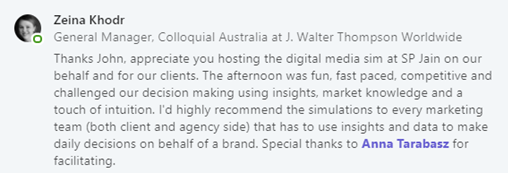


DIGITAL MediaPRO allows participants to understand in depth how marketing communications are managed across consumers, regions and media type to drive business results. Learning points include:
• Targeting Consumers: Selection of the ‘right’ target consumers and a focus on them over time will be an important determinant of success. This brings into question segment definitions, segment attractiveness measures, and selling to multiple segments.
• Digital Transformation: Not only do media habits differ between segments, they develop over the five years. Also, network effects mean early users encourage adoption by others.
• Consumer Understanding: A good understanding of target consumers’ media habits is needed to select the most effective media to communicate with them. Placing consumers at the heart of the decision-making process is an important learning point.
• Media Selection and Spend: With a finite budget and aggressive competitors, teams must decide their media selection and budget across multiple media. Key decisions include – what are the most relevant media types to use? What spend is required to give the required Share of Voice?
• The Purchase Funnel: Consumers purchasing decisions can be aggregated into a purchase funnel showing the steps from awareness to preference and purchase intention, actual purchase, and retention and loyalty. This widely used tool is a central theme of the simulation. Teams will use this tool to drive sales, market share and profitability; Instructors will use it to debrief different approaches.
• Budget Allocation across Regions and Seasonality: With three regions and varying demand over the year it will be a challenge to balance spending to maximize ROI.
• Competitor Analysis: Analysis should go beyond defining the main competitor(s) and monitoring their actions. Anticipating their next moves will help in the fight for Share of Voice.
• Return on Media Investment: Marketing’s contribution to profitability can be explored by calculating teams’ return on media investment. The relative contribution of strategy and tactics may be discussed.
The DIGITAL MediaPRO Challenge
Participants define and execute the media strategy needed to achieve the company’s aggressive objective of driving their energy drink brand MOJO to undisputed market leadership within a period of five years.
• Performance will be assessed each year on two measures – success in media management, and business results.
• Media management skills are assessed on how well participants connect with and influence consumers in their purchase decisions, summarized in the ‘Funnel Index’.
• The business results – sales, market share gain and improved profit – are combined in an Overall Performance Index (OPI)
Maximize your OPI with various tactics.
To succeed in DIGITAL MediaPRO, participants must focus on understanding consumers and their media habits, deal with the complexity of a rapidly growing market, and manage communications effectively in a competitive environment.
DIGITAL MediaPRO allows participants to manage an energy drink brand over a period of 5 simulated years.
On average, instructors set 3 hours for the teams to analyse, decide and run the 5 decision rounds. However, DIGITAL MediaPRO is fully flexible and can be adapted to different course agendas and set-up. Instructors have full control as to when the simulation starts and stops, and may insert side sessions and exercises.
DIGITAL MediaPRO uses team against computer competition.
There is complete flexibility in the number of teams, which makes DIGITAL MediaPRO accessible for any class size (from a few students to more than 300).




![decide-logo[5]-1.jpg decide-logo[5]-1.jpg](https://www.spjain.edu.au/hs-fs/hubfs/decide-logo%5B5%5D-1.jpg?width=842&name=decide-logo%5B5%5D-1.jpg)
